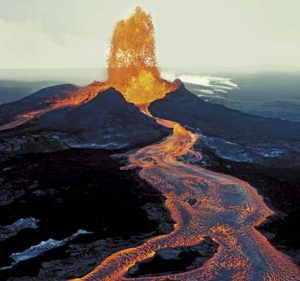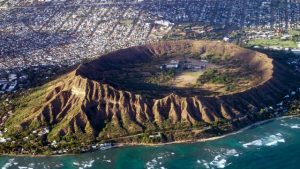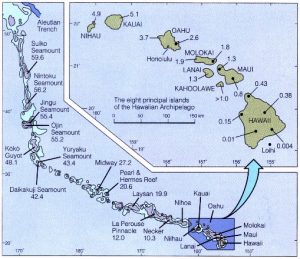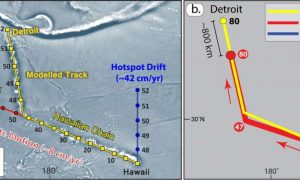Geologists have learned a great deal in the last fifty years about the mechanics of how volcanoes are created and operate. According to the modern theory of ‘Plate Tectonics’ the surface of the Earth consists of a number of hard plates that ride over our planet’s softer, more fluid mantel. These plates move around the surface of the earth very slowly with time. As the plates move they can either pull apart from or collide into each other and those are the areas of the Earth where seismic activity like earthquakes or volcanoes normally occurs.
Normally, but not always, the volcanoes that have formed the Hawaiian Islands are a major exception to this model. Geologists have recognized the existence of a stationary ‘Hotspot’ in the Pacific Ocean that is presently feeding the active volcano of Kilauea on Hawaii’s big Island.
The Kilauea volcano is only about half a million years old however and before then the hotspot generated the now extinct volcanoes of Mauna Kea, Diamond Head and all of the other volcanoes of the Hawaiian chain. The images below show Kilauea and Diamond Head.


In fact, as the Pacific Tectonic Plate has moved northwestward over the last 70 million years the hotspot has generated a long series of now extinct volcanoes known as the Hawaiian-Emperor chain. Most of these volcanic peaks have now dropped back below the surface of the ocean but the entire chain stretches in a straight line from Kilauea almost to the Aleutian Islands. The illustration below shows what the Hawaiian-Emperor chain would look like if the water of the Pacific Ocean were removed.

Recently more accurate underwater mapping of the Hawaiian-Emperor chain has led researchers at the GFZ Research Center for Geosciences in Germany to conclude that the Hawaiian-Emperor chain may not be as straight as was thought. According to the scientists at GFZ about 47 million years ago the chain took a temporary bend to the left, as seen from Hawaii, an indication that the hotspot had moved several dozen miles to the south over the course of around a million years. The image below shows the bend identified by the geologists.

“If you try to explain this bend with just a sudden change in the movement of the Pacific Plate.” Says Bernhard Steinberger a researcher at GFZ. “You would expect a significantly different direction of motion at that time relative to adjacent tectonic plates. But we have not found any evidence for that.”
The scientists also checked the position of the Hawaiian hot spot against two other hot spots, the Rurutu volcanic chain in the western Pacific and the Louisville chain in the southern Pacific. The results indicate that it was the Hawaiian hotpot that moved some 50 million years ago.
The geologists at GFZ will continue to study the movement of the Hawaiian hotspot. “With more field data and information about the processes deep in the mantel, we hope to explain in more detail how the bend in the Hawaiian-Emperor chain has evolved.” Steinberger said.
The more we learn about volcanoes the better we will be able to understand how the Earth itself works. I look forward to hearing more from the GFZ Research Center for Geosciences about their work on the Hawaiian hotspot.
